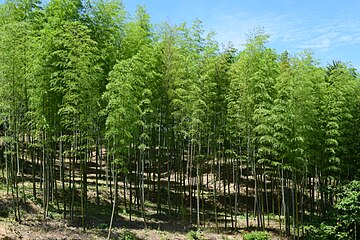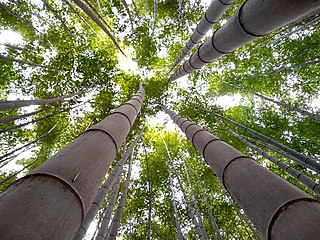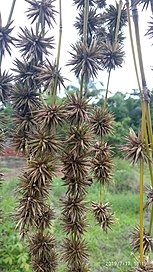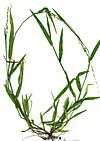Bamboo
| Bamboo Temporal range: Early Eocene – Present
| |
|---|---|
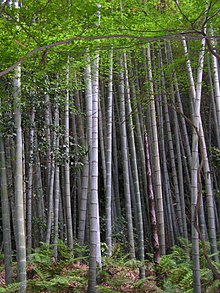
| |
| Bamboo forest in Hunan, China
| |
| Scientific classification | |
| Kingdom: | Plantae |
| Clade: | Tracheophytes |
| Clade: | Angiosperms |
| Clade: | Monocots |
| Clade: | Commelinids |
| Order: | Poales |
| Family: | Poaceae |
| Clade: | BOP clade |
| Subfamily: | Bambusoideae Luerss. |
| Tribes | |
| Diversity[1] | |
| >1,462 (known species) species in 115 genera | |
| Synonyms[2] | |
| Bamboo | ||
|---|---|---|
Tâi-lô tik | | |
| Transcriptions | |
|---|---|
| Revised Romanization | daenamu |
| Transcriptions | |
|---|---|
| Romanization | take |
Bamboos are a diverse group of mostly
In bamboo, as in other grasses, the internodal regions of the stem are usually hollow and the vascular bundles in the cross-section are scattered throughout the walls of the culm instead of in a cylindrical cambium layer between the bark (phloem) and the wood (xylem) as in dicots and conifers. The dicotyledonous woody xylem is also absent. The absence of secondary growth wood causes the stems of monocots, including the palms and large bamboos, to be columnar rather than tapering.[12]
Bamboos include some of the fastest-growing plants in the world,[13] due to a unique rhizome-dependent system. Certain species of bamboo can grow 91 centimetres (36 inches) within a 24-hour period, at a rate of almost 40 millimeters (1+1⁄2 in) an hour (equivalent to 1 mm every 90 seconds).[14] Growth up to 120 centimeters (47.6 inches) in 24 hours has been observed in the instance of Japanese giant timber bamboo (Phyllostachys bambusoides).[15] This rapid growth and tolerance for marginal land, make bamboo a good candidate for afforestation, carbon sequestration and climate change mitigation.[16][17][18]
Bamboo is versatile and has notable economic and cultural significance in
Taxonomy
| |||||||||||||||||||||
Bamboos have long been considered the most basal grass genera, mostly because of the presence of
The bamboos comprise three clades classified as tribes, and these strongly correspond with geographic divisions representing the New World herbaceous species (
21 genera:
- Subtribe Buergersiochloinae
- one genus: Buergersiochloa.
- Subtribe Olyrineae
- 17 genera: Agnesia, Arberella, Cryptochloa, Diandrolyra, Ekmanochloa, Froesiochloa, Lithachne, Maclurolyra, Mniochloa, Olyra, Parodiolyra, Piresiella, Raddia, Raddiella, Rehia, Reitzia (syn. Piresia), Sucrea.
- Subtribe Parianinae
- three genera: Eremitis, Pariana, Parianella.
73 genera:
- Subtribe Arthrostylidiinae:
- Subtribe Bambusinae:
- 17 genera: Maclurochloa, Melocalamus, Neomicrocalamus, Oreobambos, Oxytenanthera, Phuphanochloa, Pseudoxytenanthera, Soejatmia, Thyrsostachys, Vietnamosasa, Yersinochloa.
- 17 genera:
- Subtribe Chusqueinae:
- one genus: Chusquea.
- Subtribe Dinochloinae:
- 7 genera: Cyrtochloa, Dinochloa, Mullerochloa, Neololeba, Pinga, Parabambusa, Sphaerobambos.
- Subtribe Greslaniinae:
- one genus: Greslania.
- Subtribe Guaduinae:
- 5 genera: Apoclada, Eremocaulon, Guadua, Olmeca, Otatea.
- Subtribe Hickeliinae:
- 9 genera: Cathariostachys, Decaryochloa, Hickelia, Hitchcockella, Nastus, Perrierbambus, Sirochloa, Sokinochloa, Valiha.
- Subtribe Holttumochloinae:
- 3 genera: Holttumochloa, Kinabaluchloa, Nianhochloa.
- Subtribe Melocanninae:
- 9 genera: Stapletonia.
- 9 genera:
- Subtribe Racemobambosinae:
- 3 genera: Chloothamnus, Racemobambos, Widjajachloa.
- 3 genera:
- Subtribe Temburongiinae:
- one genus: Temburongia.
- incertae sedis
- 2 genera: Ruhooglandia, Temochloa.
31 genera: Acidosasa, Ampelocalamus, Arundinaria, Bashania, Bergbambos, Chimonobambusa, Chimonocalamus, Drepanostachyum, Fargesia, Ferrocalamus, Gaoligongshania, Gelidocalamus, Himalayacalamus, Indocalamus, Indosasa, Kuruna, Oldeania, Oligostachyum, Phyllostachys, Pleioblastus, Pseudosasa, Sarocalamus, Sasa, Sasaella, Sasamorpha, Semiarundinaria, Shibataea, Sinobambusa, Thamnocalamus, Vietnamocalamus, Yushania.
Distribution

Most bamboo species are native to warm and moist tropical and to warm temperate climates.[27] Their range also extends to cool mountainous regions and highland cloud forests.
In the
Three species of bamboo, all in the genus Arundinaria, are also native through Central America and Mexico, northward into the Southeastern United States.[31] Bamboo thickets called canebrakes once formed a dominant ecosystem in some parts of the Southeastern United States, but they are now considered critically endangered ecosystems.[32][33][34] Canada and continental Europe are not known to have any native species of bamboo.[35] Many species are also cultivated as garden plants outside of this range, including in Europe and areas of North America where no native wild bamboo exists.
Recently, some attempts have been made to grow bamboo on a commercial basis in the Great Lakes region of east-central Africa, especially in Rwanda.[36] In the United States, several companies are growing, harvesting, and distributing species such as Phyllostachys nigra (Henon) and Phyllostachys edulis (Moso).[37]
-
Bamboo forest in Arashiyama, Kyoto, Japan
-
Serra dos Órgãos National Park, Brazil
-
Bamboo forest in Guangde, China
-
Bamboo forest, Gochangupseong Fortress, South Korea
-
Arundinaria gigantea, a North American bamboo, in Kentucky
-
Panoramic view of bamboo forest in Hawaii
Ecology

The two general patterns for the growth of bamboo are "clumping", and "running", with short and long underground rhizomes, respectively. Clumping bamboo species tend to spread slowly, as the growth pattern of the rhizomes is to simply expand the root mass gradually, similar to ornamental grasses. Running bamboos need to be controlled during cultivation because of their potential for aggressive behavior. They spread mainly through their rhizomes, which can spread widely underground and send up new culms to break through the surface. Running bamboo species are highly variable in their tendency to spread; this is related to the species, soil and climate conditions. Some send out runners of several meters a year, while others stay in the same general area for long periods. If neglected, over time, they can cause problems by moving into adjacent areas.
Bamboos include some of the fastest-growing plants on Earth, with reported growth rates up to 910 mm (36 in) in 24 hours.
Unlike all trees, individual bamboo culms emerge from the ground at their full diameter and grow to their full height in a single growing season of three to four months. During this time, each new shoot grows vertically into a culm with no branching out until the majority of the mature height is reached. Then, the branches extend from the nodes and leafing out occurs. In the next year, the pulpy wall of each culm slowly hardens. During the third year, the culm hardens further. The shoot is now a fully mature culm. Over the next 2–5 years (depending on species), fungus begins to form on the outside of the culm, which eventually penetrates and overcomes the culm.[citation needed] Around 5–8 years later (species- and climate-dependent), the fungal growths cause the culm to collapse and decay. This brief life means culms are ready for harvest and suitable for use in construction within about three to seven years. Individual bamboo culms do not get any taller or larger in diameter in subsequent years than they do in their first year, and they do not replace any growth lost from pruning or natural breakage. Bamboo has a wide range of hardiness depending on species and locale. Small or young specimens of an individual species produce small culms initially. As the clump and its rhizome system mature, taller and larger culms are produced each year until the plant approaches its particular species limits of height and diameter.
Many tropical bamboo species die at or near freezing temperatures, while some of the hardier temperate bamboos survive temperatures as low as −29 °C (−20 °F). Some of the hardiest bamboo species are grown in USDA plant hardiness zone 5,[citation needed] although they typically defoliate and may even lose all above-ground growth, yet the rhizomes survive and send up shoots again the next spring. In milder climates, such as USDA zone 7 and above, most bamboo remain fully leafed out and green year-round.
Mass flowering

Bamboos seldom and unpredictably flower and the frequency of flowering varies greatly from species to species. Once flowering takes place, a plant declines and often dies entirely. In fact, many species only flower at intervals as long as 65 or 120 years. These taxa exhibit
Invasive species
Some bamboo species are acknowledged as having high potential for becoming
Animal diet

Bamboo contains large amounts of protein and very low amounts of carbohydrates allowing this plant to be the source of food for many animals.[44] Soft bamboo shoots, stems and leaves are the major food source of the giant panda[45] of China, the red panda[46] of Nepal, and the bamboo lemurs of Madagascar.[47] The red panda can eat up to 9 pounds (4.1 kg) a day which is also about the full body weight of the animal.[47] With raw bamboo containing trace amounts of harmful cyanide with higher concentrations in bamboo shoots, the golden bamboo lemur ingests many times the quantity of the taxiphyllin-containing bamboo that would be lethal to a human.[47]
Cultivation
General

Bamboo forestry (also known as bamboo farming, cultivation, agriculture or agroforestry) is a cultivation and raw material industry that provides the raw materials for the broader bamboo industry, worth over 72 billion dollars globally in 2019.[49]
Historically a dominant raw material in South and South East Asia, the global bamboo industry has significantly grown in recent decades in part because of the high sustainability of bamboo as compared to other biomass cultivation strategies, such as traditional timber forestry. For example, as of 2016, the U.S. Fiber corporation Resource Fiber is contracting farmers in the United States for bamboo cultivation.[50][49] Or in 2009, United Nations Industrial Development Organization published guidelines for cultivation of bamboo in semi-arid climates in Ethiopia and Kenya.[51]
Because bamboo can grow on otherwise
Bamboo is harvested from both cultivated and wild stands, and some of the larger bamboos, particularly species in the genus Phyllostachys, are known as "timber bamboos". Bamboo is typically harvested as a source material for construction, food, crafts and other manufactured goods.[57]
Bamboo cultivation in South, South East Asia and East Asia stretches back thousands of years. One practice, in South Korea, has been designated as a Globally Important Agricultural Heritage Systems.[citation needed]In Brazil, the Brazilian Center for Innovation and Sustainability - CEBIS, a non-profit organization, promotes the development of Brazil's bamboo production chain. Last year[when?], it helped with the approval of law n~21,162 in the state of Paraná, which encourages Bamboo Culture aiming at the dissemination of its agricultural cultivation and the valorization of bamboo as an instrument for promoting the sustainable socioeconomic development of the State through its multiple functionalities. Bamboo cultivation neutralizes carbon emissions. Bamboo cultivation is cheap and in addition to adding value to its production chain, it is a sustainable crop that brings environmental, economic and social benefits. Its production can be used from construction to food. Recently, it was qualified and classified for the National Commission for Sustainable Development Objectives - CNDOS of the Presidency of the Republic of the federal government of Brazil.
Harvesting

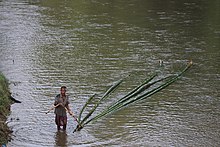
Bamboo used for construction purposes must be harvested when the culms reach their greatest strength and when sugar levels in the sap are at their lowest, as high sugar content increases the ease and rate of pest infestation. As compared to forest trees, bamboo species grow fast. Bamboo plantations can be readily harvested for a shorter period than tree plantations.[58]
Harvesting of bamboo is typically undertaken according to these cycles:
- Lifecycle of the culm: As each individual culm goes through a five to seven-year lifecycle, they are ideally allowed to reach this level of maturity prior to full capacity harvesting. The clearing out or thinning of culms, particularly older decaying culms, helps to ensure adequate light and resources for new growth. Well-maintained clumps may have a productivity three to four times that of an unharvested wild clump. Consistent with the lifecycle described above, bamboo is harvested from two to three years through to five to seven years, depending on the species.[59][60]
- Annual cycle: Most all growth of new bamboo occurs during the wet season and disturbing the clump during this phase will potentially damage the upcoming crop, while harvesting immediately prior to the wet/growth season may also damage new shoots, therefore harvesting is best a few months prior to the start of the wet season.[61] Also during this high-rainfall period, sap levels are at their highest, and then diminish towards the dry season.[62]
- Daily cycle: During the height of the day, photosynthesis is at its peak, producing the highest levels of sugar in sap, making this the least ideal time of day to harvest and many traditional practitioners believe the best time to harvest is at dawn or dusk on a waning moon.[63]
Leaching
Leaching is the removal of sap after harvest. In many areas of the world, the sap levels in harvested bamboo are reduced either through leaching or post-harvest photosynthesis. For example:
- Cut bamboo is raised clear of the ground and leaned against the rest of the clump for one to two weeks until leaves turn yellow to allow full consumption of sugars by the plant.
- A similar method is undertaken, but with the base of the culm standing in fresh water, either in a large drum or stream to leach out sap.
- Cut culms are immersed in a running stream and weighted down for three to four weeks.
- Water is pumped through the freshly cut culms, forcing out the sap (this method is often used in conjunction with the injection of some form of treatment).
In the process of water leaching, the bamboo is dried slowly and evenly in the shade to avoid cracking in the outer skin of the bamboo, thereby reducing opportunities for pest infestation.
Durability of bamboo in construction is directly related to how well it is handled from the moment of planting through harvesting, transportation, storage, design, construction, and maintenance. Bamboo harvested at the correct time of year and then exposed to ground contact or rain will break down just as quickly as incorrectly harvested material.[64]
Toxicity
Gardeners working with bamboo plants have occasionally reported
Uses
Culinary

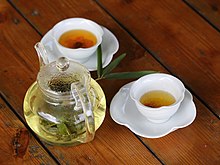
The shoots of most species are edible either raw or cooked, with the tough sheath removed. Cooking removes the slight bitterness.[69] The shoots are used in numerous Asian dishes and broths, and are available in supermarkets in various sliced forms, in both fresh and canned versions.
The bamboo shoot in its fermented state forms an important ingredient in cuisines across the Himalayas. In Assam, India, for example, it is called khorisa.[70] In Nepal, a delicacy popular across ethnic boundaries consists of bamboo shoots fermented with turmeric and oil, and cooked with potatoes into a dish that usually accompanies rice (alu tama[71] (आलु तामा) in Nepali).
In Indonesia, they are sliced thin and then boiled with santan (thick coconut milk) and spices to make a dish called gulai rebung. Other recipes using bamboo shoots are sayur lodeh (mixed vegetables in coconut milk) and lun pia (sometimes written lumpia: fried wrapped bamboo shoots with vegetables). The shoots of some species contain toxins that need to be leached or boiled out before they can be eaten safely.
Pickled bamboo, used as a condiment, may also be made from the pith of the young shoots.
The sap of young stalks tapped during the rainy season may be

Pickled bamboo shoots (Nepali: तामा tama) are cooked with black-eyed beans as a delicacy in Nepal. Many Nepalese restaurants around the world serve this dish as aloo bodi tama. Fresh bamboo shoots are sliced and pickled with mustard seeds and turmeric and kept in glass jar in direct sunlight for the best taste. It is used alongside many dried beans in cooking during winters. Baby shoots (Nepali: tusa) of a very different variety of bamboo (Nepali: निगालो Nigalo) native to Nepal is cooked as a curry in hilly regions.
In
In Konkani cuisine, the tender shoots (kirlu) are grated and cooked with crushed jackfruit seeds to prepare kirla sukke.
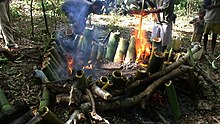
In southern India and some regions of southwest China, the seeds of the dying bamboo plant are consumed as a grain known as "bamboo rice". The taste of cooked bamboo seeds is reported to be similar to wheat and the appearance similar to rice, but bamboo seeds have been found to have lower nutrient levels than both.[75] The seeds can be pulverized into a flour with which to make cakes.[69]
The Indian state of Sikkim has promoted bamboo water bottles to keep the state free from plastic bottles[76]
The empty hollow in the stalks of larger bamboo is often used to cook food in many Asian cultures. Soups are boiled and rice is cooked in the hollows of fresh stalks of bamboo directly over a flame. Similarly, steamed tea is sometimes rammed into bamboo hollows to produce compressed forms of pu'er tea. Cooking food in bamboo is said to give the food a subtle but distinctive taste.
Fuel

Bamboo charcoal is charcoal made from species of bamboo. Bamboo charcoal is typically made from the culms or refuse of mature bamboo plants and burned in ovens at temperatures ranging from 600 to 1200 °C. It is an especially porous charcoal, making it useful in the manufacture of activated carbon.[77]
Bamboo charcoal has a long history of use in China, with documents dating as early as 1486 during the Ming dynasty in Chuzhou.[78] There is also mention of it during the Qing dynasty, during the reigns of emperors Kangxi, Qianlong, and Guangxu.[79]Working

Writing surface
Bamboo was in widespread use in early China as a medium for written documents. The earliest surviving examples of such documents, written in ink on string-bound bundles of bamboo strips (or "slips"), date from the fifth century BC during the
Bamboo or wooden strips were used as the standard writing material during the early Han dynasty, and excavated examples have been found in abundance.[80] Subsequently, paper began to displace bamboo and wooden strips from mainstream uses, and by the fourth century AD, bamboo slips had been largely abandoned as a medium for writing in China.
Bamboo fiber has been used to make paper in China since early times. A high-quality, handmade bamboo paper is still produced in small quantities. Coarse bamboo paper is still used to make spirit money in many Chinese communities.[81]
Bamboo
In Central India, there are regular bamboo working circles in forest areas of Maharashtra, Madhyapradesh, Odisha and Chhattisgarh. Most of the bamboo is harvested for papermaking. Bamboo is cut after three years of its germination. No cutting is done during the rainy season (July–September); broken and malformed culms are harvested first.[84]
Writing pen
In olden times, people in India used hand-made pens (known as Kalam or boru (बोरू)) made from thin bamboo sticks (with diameters of 5–10 mm and lengths of 100–150 mm) by simply peeling them on one side and making a nib-like pattern at the end. The pen would then be dipped in ink for writing.[85]
Textiles
Since the fibers of bamboo are very short (less than 3 mm or 1⁄8 in), they are not usually transformed into yarn by a natural process. The usual process by which textiles labeled as being made of bamboo are produced uses only rayon made from the fibers with heavy employment of chemicals. To accomplish this, the fibers are broken down with chemicals and extruded through mechanical spinnerets; the chemicals include lye, carbon disulfide, and strong acids.[86] Retailers have sold both end products as "bamboo fabric" to cash in on bamboo's current ecofriendly cachet. The Canadian Competition Bureau[87] and the US Federal Trade Commission,[88] as of mid-2009, are cracking down on the practice of labeling bamboo rayon as natural bamboo fabric. Under the guidelines of both agencies, these products must be labeled as rayon with the optional qualifier "from bamboo".[88]
Fabric

Examples include clothing such as shirt tops, pants, and socks for adults and children, as well as bedding[89] such as sheets and pillow covers. Bamboo yarn can also be blended with other textile fibres, such as hemp or spandex. Bamboo is an alternative to plastic that is renewable and can be replenished at a fast rate.
Modern clothing labeled as being made from bamboo is usually viscose rayon, a fiber made by dissolving the cellulose in the bamboo, and then extruding it to form fibres. This process removes the natural characteristics of bamboo fibre, rendering it identical to rayon from other cellulose sources. Only products made directly from bamboo fiber should carry the "bamboo" label.[90]Construction

Bamboo, like true wood, is a natural building material with a high strength-to-weight ratio useful for structures.[19] In its natural form, bamboo as a construction material is traditionally associated with the cultures of South Asia, East Asia, and the South Pacific, to some extent in Central and South America, and by extension in the aesthetic of Tiki culture.
In China and India, bamboo was used to hold up simple suspension bridges, either by making cables of split bamboo or twisting whole culms of sufficiently pliable bamboo together. One such bridge in the area of Qian-Xian is referenced in writings dating back to 960 AD and may have stood since as far back as the third century BC, due largely to continuous maintenance.[citation needed][91]

Bamboo has also long been used as scaffolding; the practice has been banned in China for buildings over six stories, but is still in continuous use for skyscrapers in Hong Kong.[92]
In the Philippines, the
In Japanese architecture, bamboo is used primarily as a supplemental or decorative element in buildings such as fencing, fountains, grates, and gutters, largely due to the ready abundance of quality timber.[93]
Many ethnic groups in remote areas that have water access in Asia use bamboo that is 3–5 years old to make rafts. They use 8 to 12 poles, 6–7 m (20–23 ft) long, laid together side by side to a width of about 1 m (3 ft). Once the poles are lined up together, they cut a hole crosswise through the poles at each end and use a small bamboo pole pushed through that hole like a screw to hold all the long bamboo poles together. Floating houses use whole bamboo stalks tied together in a big bunch to support the house floating in the water.
Fishing and aquaculture
Due to its flexibility, bamboo is also used to make
Firecrackers
Bamboo has been traditionally used in Malaysia as a firecracker called a meriam buluh or bamboo cannon. Four-foot-long sections of bamboo are cut, and a mixture of water and calcium carbide are introduced. The resulting acetylene gas is ignited with a stick, producing a loud bang.
Weapons
Bamboo has often been used to construct weapons and is still incorporated in several Asian martial arts.
- A bamboo staff, sometimes with one end sharpened, is used in the Tamil martial art of silambam, a word derived from a term meaning "hill bamboo".
- Staves used in the Indian martial art of gatka are commonly made from bamboo, a material favoured for its light weight.
- A bamboo sword called a shinai is used in the Japanese martial art of kendo.
- Bamboo is used for crafting the bows, called yumi, and arrows used in the Japanese martial art kyūdō.
- The first gunpowder-based weapons, such as the fire lance, were made of bamboo.
- Sharpened bamboo land and naval warfare in the Philippines. They were thrown in groups at a time at enemy ships or massed enemy formations. Non-disposable finely-crafted throwing spears made from bamboo weighted with sand known as sugob were also used. Sugob were mainly used for close-quarters combat and were only thrown when they could be retrieved.[94][95]
- Metal-tipped
- The simple sharpened bamboo naval supremacy along with Commonwealth aid.[citation needed]
- booby traps. Punji sticks were widely used in the Vietnam War by the Viet Cong.
Desalination
Bamboo can be used in water desalination. A bamboo filter is used to remove the salt from seawater.[98][dubious ]
Musical instruments

Indicator of climate change
The
Kitchenware and other usage

Bamboo is frequently used for cooking utensils within many cultures, and is used in the manufacture of chopsticks. In modern times, some see bamboo tools as an eco-friendly alternative to other manufactured utensils. Bamboo is also used to make eating utensils such as chopsticks, trays, and tea scoops. Several manufacturers offer bamboo bicycles, surfboards, snowboards, and skateboards.[102][103]
Bamboo has traditionally been used to make a wide range of everyday utensils and cutting boards, particularly in Japan,[104] where archaeological excavations have uncovered bamboo baskets dating to the Late Jōmon period (2000–1000 BC).[105] Bamboo also has a long history of use in Asian furniture. Chinese bamboo furniture is a distinct style based on a millennia-long tradition, and bamboo is also used for floors due to its high hardness.[106]
In culture
Several Asian cultures, including that of the Andaman Islands, believe humanity emerged from a bamboo stem.
China
Bamboo's long life makes it a Chinese symbol of uprightness and an Indian symbol of friendship. The rarity of its blossoming has led to the flowers' being regarded as a sign of impending famine. This may be due to rats feeding upon the profusion of flowers, then multiplying and destroying a large part of the local food supply. The most recent flowering began in May 2006 (see Mautam). Various bamboo species bloom in this manner about every 28–60 years.[107]
In
Attributions of character


Bamboo, one of the "Four Gentlemen" (bamboo, orchid, plum blossom and chrysanthemum), plays such an important role in traditional Chinese culture that it is even regarded as a behavior model of the gentleman. As bamboo has features such as uprightness, tenacity, and modesty, people endow bamboo with integrity, elegance, and plainness, though it is not physically strong. Countless poems praising bamboo written by ancient Chinese poets are actually metaphorically about people who exhibited these characteristics. An ancient poet, Bai Juyi (772–846), thought that to be a gentleman, a man does not need to be physically strong, but he must be mentally strong, upright, and perseverant. Just as a bamboo is hollow-hearted, he should open his heart to accept anything of benefit and never have arrogance or prejudice.
Bamboo is not only a symbol of a gentleman, but also plays an important role in Buddhism, which was introduced into China in the first century. As canons of Buddhism forbids cruelty to animals, flesh and egg were not allowed in the diet. The tender bamboo shoot (sǔn 筍 in Chinese) thus became a nutritious alternative. Preparation methods developed over thousands of years have come to be incorporated into Asian cuisines, especially for monks. A Buddhist monk, Zan Ning, wrote a manual of the bamboo shoot called Sǔn Pǔ (筍譜) offering descriptions and recipes for many kinds of bamboo shoots.[108] Bamboo shoot has always been a traditional dish on the Chinese dinner table, especially in southern China. In ancient times, those who could afford a big house with a yard would plant bamboo in their garden.
Mythology
In a Chinese legend, the Emperor Yao gave two of his daughters to the future Emperor Shun as a test for his potential to rule. Shun passed the test of being able to run his household with the two emperor's daughters as wives, and thus Yao made Shun his successor, bypassing his unworthy son. After Shun's death, the tears of his two bereaved wives fell upon the bamboos growing there explains the origin of spotted bamboo. The two women later became goddesses Xiangshuishen after drowning themselves in the Xiang River.
Japan

Bamboo is a symbol of prosperity in Japan, and are used to make
In Japan, the Chinese "Three Friends of Winter" (kansai sanyū) concept is traditionally used as a ranking system, where pine (松 matsu) is the first rank, bamboo (竹 take) is the second rank, and plum (梅 ume) is the third rank. This system is used in many traditional arts like with
Malaysia
In Malaysia, a similar story includes a man who dreams of a beautiful woman while sleeping under a bamboo plant; he wakes up and breaks the bamboo stem, discovering the woman inside.
Philippines
In
Vietnam
Attributions of character
Bamboo plays an important part of the
During
Mythology
A bamboo cane is also the weapon of
Africa
Tanzania
Tanzania possesses a large diversity of bamboo species.[109][17]
Bozo
The Bozo ethnic group of West Africa take their name from the Bambara phrase bo-so, which means "bamboo house".
Saint Lucia
Bamboo is also the national plant of
Hawaiian
Hawaiian bamboo ('ohe) is a kinolau or body form of the Polynesian creator god Kāne.
North America
Arundinaria bamboos, known as giant cane or river cane, are a central part of the material cultures of Southeastern Native American nations, so much so that they have been called "the plastic of the Southeastern Indians."[110] Among the Cherokee, river cane has been used to make waterproof baskets, mats, fishing poles, flutes, blowguns, arrows, and to build houses, among other uses; the seed and young shoots are also edible.[111][112] Traditional Cherokee double-woven baskets, crafted from river cane that has been split and dyed in various colors, are sometimes considered among the finest in the world. Since the North American bamboos are now rare, with 98% of their original extent eliminated, the Cherokee have initiated an effort to restore it.[113]
See also
- List of bamboo species
- Bambuseae
- Bamboo blossom
- International Network for Bamboo and Rattan
- Bamboo construction
- Bamboo textile
- Bamboo processing machine
- Ceremonial pole
- Mautam
References
- ^ PMID 23454093. Archived from the original(PDF) on 5 June 2015.
- S2CID 84052108.

- ISBN 978-0-674-42871-3, retrieved 29 August 2023
- PMID 28013249.
- ^ S2CID 259134632.
- ^ "World's Biggest Bamboo Plant Found in Southwest China". Forest Conservation Portal. 28 August 2003. Archived from the original on 10 November 2003. Retrieved 4 April 2004.
- ^ <anonymous> (n.d.). "Bamboos of Thailand - Kinabaluchloa wrayi". Retrieved 24 February 2015.
- ^ Schombergk, Sir Robert H. (1841). "Some Accounts of the Curata....etc". Trans. Linnean Soc. London. 18 (<not stated>): 559–560.
- ^ Judziewicz, Emmit J.; Sepsenwol, Sol (2007). "The World's Smallest Bamboo: Raddiella Vanessiae (Poaceae: Bambusoideae: Olyreae), a New Species from French Guiana". Journal of the Botanical Research Institute of Texas. 1 (1): 1–7.
- PMID 23454093.
- ^ "bamboo". Oxford English Dictionary (Online ed.). Oxford University Press. (Subscription or participating institution membership required.)
- ^ Wilson, C.L. & Loomis, W.E. Botany (3rd ed.). Holt, Rinehart and Winston.
- ISBN 978-0-87156-825-0.
- ^ a b "Fastest growing plant". Guinness World Records. Archived from the original on 3 September 2014. Retrieved 22 August 2014.
- ^ Austin, Robert; Ueda, Koishiro (1970). Bamboo. New York: Walker/Weatherhill. p. 193.
- S2CID 225025086.
- ^ S2CID 253535691.
- S2CID 232067180.
- ^ .
- ^ Kaminski, S.; Lawrence, A.; Trujillo, D. (2016). "Structural use of bamboo. Part 1: Introduction to bamboo". The Structural Engineer. 94 (8): 40–43.
- ^ Kaminski, S.; Lawrence, A.; Trujillo, D.; Feltham, I.; Felipe López, L. (2016). "Structural use of bamboo. Part 3: Design values". The Structural Engineer. 94 (12): 42–45.
- ^ McClure, Floyd A. (1948). 1948 Yearbook of Agriculture - Grasses. Washington, D.C.: United States Department of Agriculture. p. 738.
- ^ Farrelly, David (1984). The Book of Bamboo. San Francisco: Sierra Club Books. p. 143.
- ^ PMID 22115274.
- JSTOR 2419803.
- S2CID 239748950, retrieved 29 August 2023
- ^ Kitsteiner, John (13 January 2014). "Permaculture Plants: Bamboo". tcpermaculture.com. Archived from the original on 31 July 2017. Retrieved 28 July 2017.
- ^ Newell, J (2004). "Chapter 11: Sakhalin Oblast" (PDF). The Russian Far East: A Reference Guide for Conservation and Development. McKinleyville, California: Daniel & Daniel. pp. 376, 384–386, 392, 404. Archived (PDF) from the original on 3 July 2014. Retrieved 18 June 2014.
- S2CID 35784749.
- ^ a b "Gorillas get drunk on bamboo sap". The Daily Telegraph. 23 March 2009. Archived from the original on 26 March 2009. Retrieved 12 August 2009.
- ^ USDA, NRCS (n.d.). "Arundinaria gigantea (Walt.) Muhl. giant cane". The PLANTS Database (plants.usda.gov). Greensboro, North Carolina: National Plant Data Team.
- ^ "Canebrake Restoration". friendsofthecache.org. Retrieved 27 November 2022.
- S2CID 90442090.
- ^ Barret, Richard; Grabowski, Janet; Williams, M.J. "Giant Cane and Other Native Bamboos: Establishment and Use for Conservation of Natural Resources in the Southeast" (PDF). ncrs.usda.gov.
- ISBN 978-0-333-47494-5.
- ^ "Bamboo Farming: An Opportunity To Transform Livelihoods". The New Times. 6 June 2010. Archived from the original on 11 September 2016. Retrieved 2 August 2016.
- ^ McDill, Stephen. "MS Business Journal". MS Business Journal. Archived from the original on 11 July 2011. Retrieved 7 July 2011.
- PMID 25963600. Archived from the original(PDF) on 11 September 2015.
- ISBN 9780674061507.
- JSTOR 2388036.
- ^ "Bamboos and invasiveness". INBAR. 25 May 2018. Retrieved 31 July 2020.
- ^ "Terrestrial Invasives: Golden Bamboo". InvasiveSpeciesInfo.gov. U.S. Department of Agriculture.
- S2CID 173992065.
- ^ Daley, Jason. "Bamboo Is Basically 'Fake Meat' for Giant Pandas". Smithsonian Magazine.
- ^ "What do pandas eat? And other giant panda facts". WWF. Retrieved 27 March 2023.
- ^ "Where do red pandas live? And other red panda facts". WWF. Retrieved 27 March 2023.
- ^ a b c Suresh, Rahul (28 March 2023). "What Animals Eat Bamboo?".
- S2CID 91400323.
- ^ a b Gray, Audrey (11 January 2021). "The Radical Case for Growing Huge Swaths of Bamboo in North America". Inside Climate News. Retrieved 13 January 2021.
- ^ Bennet, Chris (31 October 2016). "Bamboo Set to go Big on U.S. Farmland". Farm Journal.
- ^ Bamboo Cultivation Manual Guidelines for Cultivating Ethiopian Lowland Bamboo (PDF). UNIDO. 2009.
- S2CID 159340063.
- ^ "New Report Reveals the Benefits of Bamboo for Land Restoration". International Bamboo and Rattan Organisation.
- ^ "Understanding Bamboo's Climate Change Potential". International Bamboo and Rattan Organisation.
- ^ The Poor Man's Carbon Sink Bamboo in Climate Change and Poverty Alleviation (PDF). FAO Forestry Department. 2009.
- ^ "About International Network for Bamboo and Rattan". INBAR. Retrieved 31 July 2020.
- ^ "Bamboo: A Multipurpose Agroforestry Crop". Small Farmer's Journal. 21 July 2016. Retrieved 30 July 2020.
- ISBN 978-971-579-058-1.
- ^ Panda, H. (6 October 2011). Bamboo Plantation and Utilization Handbook. Asia Pacific Business Press, Inc. p. 168.
- ^ Marie, Joanne. "Bamboo Harvesting and Growing". Hearst Newspapers. Week&.
- ^ Hornaday, Fred (22 August 2022). "Harvesting Bamboo: When, why and how". Bambu Batu.
- ^ Hasan, S.M. (June 1975). "STUDIES ON GROWTH AND MATURITY OF BAMBOO CULMS". The Commonwealth Forestry Review. 54 (2): 147–153.
- ^ Schröder, Stéphane. "When and How to Harvest Bamboo". Guadua Bamboo.
- ^ Myers, Evan T. "Structural Bamboo Design in East Africa". Kansas State University. Archived from the original on 16 December 2016. Retrieved 18 June 2014.
- S2CID 36280844.
- ^ Hipler U.-C.; et al. (1986). "Typ IV-Allergie gegen Bambusblätter - ein Fallbereicht" [Type IV allergy against bamboo leaves – a case study]. Allergo J. 14: 45.
- ^ "Thinning bamboos, with itchy consequences". Succulents And More. 4 September 2012. Retrieved 3 June 2018.
- PMID 29765664.
- ^ OCLC 277203364.
- ^ "Bamboo Shoots – Khorisa". FarmToRasoi. 18 July 2020. Archived from the original on 17 December 2021. Retrieved 17 December 2021.
- ^ "Alu tama | Traditional Soup From Nepal". TasteAtlas. Retrieved 17 December 2021.
- ^ "Ulanzi (Bamboo Wine)". elkinvanaeon.net. Retrieved 17 December 2021.
- ^ Hallgren, Steve (22 July 2018). "Ulanzi: The Miracle Drink of Tanzania". Teaching High School Biology in Tanzania: A Peace Corps Volunteer Experience. Retrieved 17 December 2021.
- ^ "Kardi bhaja / Bamboo shoot cutlets Recipe by Sona Senapati". Cookpad. 14 July 2021. Retrieved 17 December 2021.
- – via Elsevier Science Direct.
- ^ "In Fight Against Plastic Pollution, Sikkim Introduces Bamboo Water Bottles For Tourists". indiatimes.com. 1 March 2020. Retrieved 4 March 2020.
- PMID 25225639.
- ISSN 0003-813X.
- .
- ISBN 978-1-55729-058-8.
- S2CID 9556185.
- ^ ISBN 978-0-615-13013-2.
- ISBN 978-3-8383-7422-2.
- ^ Shrivastav, S.S. (3 December 2002). Working Plan for Chandrapur Forest Division (PDF). Nagpur: Govt. of Maharashtra. Retrieved 23 December 2020.
- S2CID 190517335.
- .
- ^ "\"Competition Bureau Takes Action to Ensure Accuracy for Textile Articles Labelled and Advertised as Bamboo\"". Competition Bureau Canada. 27 January 2010. Retrieved 1 July 2018.
- ^ a b "Four Companies Charged with Labeling Rayon Clothing As Bamboo". GreenBiz.com. 11 August 2009. Archived from the original on 13 August 2009. Retrieved 12 August 2009.
- ^ "Why bamboo fabric and eco-friendly materials | Panda London". 12 February 2016. Retrieved 16 May 2022.
- ^ "How to Avoid Bamboozling Your Customers". Federal Trade Commission. August 2009. Retrieved 18 December 2011.
- ^ Maheshwari, Rohit (2019). "Comparison of bonding behaviour of bamboo reinforcement in concrete beam using bonding material". International Journal of Engineering Science and Computing. 9 (5): 21937 – via Research Gate.
- ^ Landler, Mark (27 March 2002). "Hong Kong Journal; For Raising Skyscrapers, Bamboo Does Nicely". The New York Times. Archived from the original on 24 April 2009. Retrieved 12 August 2009.
- ISBN 978-4-7700-2510-4.
- ISBN 9715501389.
- ISBN 9781462903474.
- ISBN 9781462905546.
- .
- UNIDO. Archived from the originalon 22 December 2009. Retrieved 30 November 2009.
- ^ Mercurio, Philip Dominguez (2006). "Traditional Music of the Southern Philippines". PnoyAndTheCity: A center for Kulintang – A home for Pasikings. Retrieved 12 June 2006.
- ISBN 9971-69-259-7. p. 15.
- ^ Needham, Joseph (1986). Science and Civilization in China: Volume 3, Mathematics and the Sciences of the Heavens and the Earth. Taipei: Caves Books, Ltd. p. 614.
- ^ Jen Lukenbill. "About My Planet: Bamboo Bikes". Archived from the original on 25 October 2012. Retrieved 4 January 2010.
- ^ Teo Kermeliotis (31 May 2012). "Made in Africa: Bamboo bikes put Zambian business on right track". CNN. Archived from the original on 23 October 2012.
- ^ Brauen, M. Bamboo in Old Japan: Art and Culture on the Threshold to Modernity. The Hans Sporry Collection in the Ethnographic Museum of Zurich University. Arnoldsche Art Publishers: Stuttgart
- ^ McCallum, T. M. Containing Beauty: Japanese Bamboo Flower Baskets. 1988. Museum of Cultural History, UCLA: Los Angeles
- ^ Lee, Andy W.C.; Liu, Yihai (June 2003). "Selected physical properties of commercial bamboo flooring". Forest Products Journal. 53 (6). Madison: 23–26. Retrieved 10 May 2017.
- ^ M. A. Huberman (1959). "Bamboo silviculture". Unasylva. 13 (1). (gregarious flowering species table). Archived from the original on 29 June 2006.
- ^ Laws, B. 2010. Bamboo. Fifty Plants that Changed the Course of History. New York:Firefly Books (U.S) Inc.
- ^ "Bamboo: Africa's untapped potential". Africa Renewal. 30 March 2016. Retrieved 29 August 2023.
- ^ "RIVER CANE Cultural Workhorse and Ecological Powerhouse" (PDF). conservationgateway.org. Revitalization of Traditional Cherokee Artisan Resources.
- ^ "River Cane – Cultural Workhorse and Ecological Powerhouse" (PDF). conservationgateway.org. Revitalization of Traditional Cherokee Artisan Resources.
- ^ "River Cane" (PDF). cherokee.org. Cherokee Nation.
- ^ Andrea L. Rogers (2023). "28". In Hoagland, Serra J.; Albert, Steven (eds.). Wildlife Stewardship on Tribal Lands. Baltimore: Johns Hopkins University Press. pp. 309–311.
Further reading
Bamboo – The Plant and its Uses. Part of the Tropical Forestry book series (TROPICAL, volume 10), 2015.
External links
- Chisholm, Hugh, ed. (1911). . Encyclopædia Britannica (11th ed.). Cambridge University Press.
- Bamboo for Climate Change by INBAR.
- Bamboo Structural Design ISO Standards



